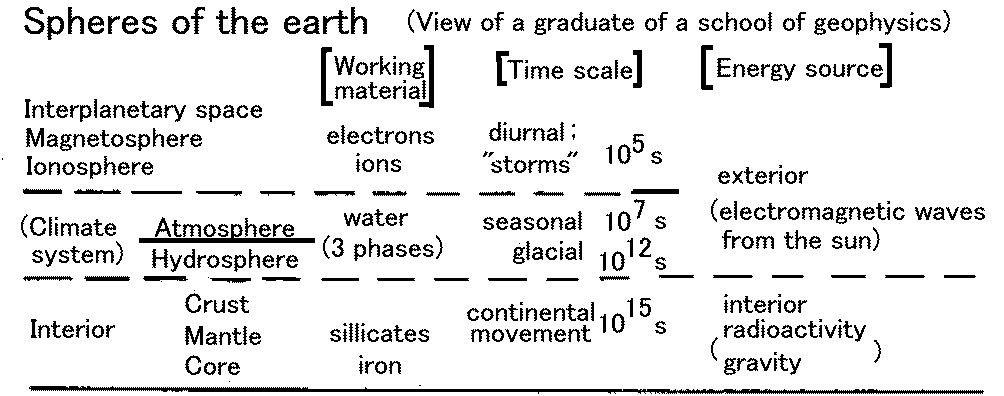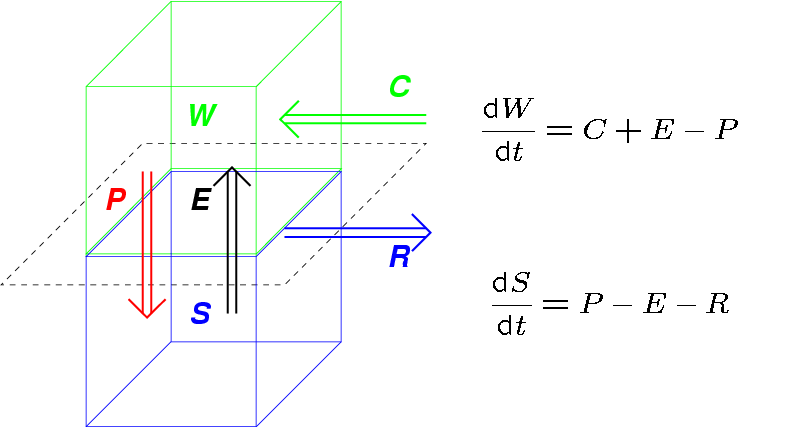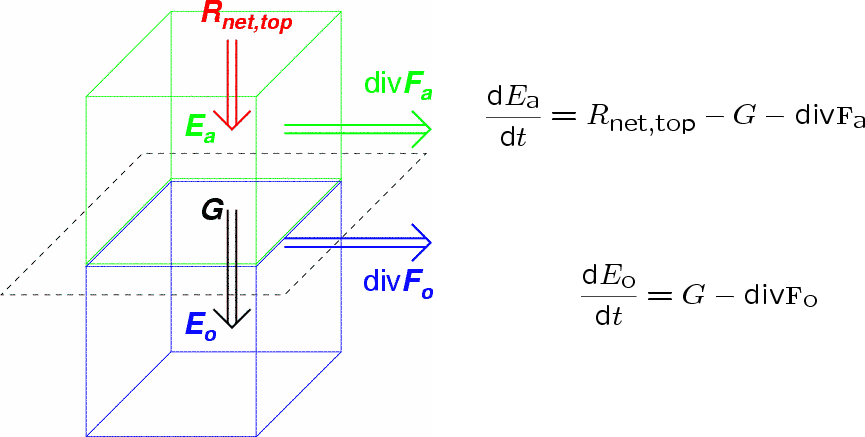Kooiti MASUDA
Frontier Research System for Global Change
Yokohama 236-0001, Japan
Advanced Seminar
on Hydrology, Meteorology, Climatology and Water Resources Studies
for Thailand
1 November 2002
at Chulalongkorn Univeristy, Bangkok, Thailand
U.S. Committee for GARP (1975): "Understanding Climate Change"
Note: English words in this figure are not faithful to the original.

- In this 1975 version, Climate System = Atmosphere + Ocean + Ice
- interacting each other by exchanging energy, water and/or momentum.
- Later variants usually include "Land (surface)" and/or "Biosphere".
- This "Land" is as deep as they interact with Atmosphere, Ocean and/or Ice
- by effectively exchanging energy, water and/or momentum.
- "Climate system" is the middle one among the three "spheres" shown.
- It is a thin layer (< 100 km) compared with the radius of the earth (6370 km).
"Climate system" (including ourselves) is a physical system,
though we cannot predict its behavior with physics alone.
- Law(s) of conservation
- ... of mass
- of mass of water (H2O, 3 phases together) ... good approximation
- of mass of air ... good approximation except that water vapor can change
- ... of energy (= first law of thermodynamics)
- ... of momentum (= Newton's equation of motion)
- (Law of increase of entropy (= second law of thermodynamics))
- Meaning of "conservation of X"
- In an isolated system, the total of X do not change with time.
- In an open system, the change of X is equal to the net inflow of X.
- dX/dt = (inflow of X) - (outflow of X)
- If a steady state can be assumed,
- 0 = (inflow of X) - (outflow of X)
- What can be gained by budget analysis?
- Estimation of unknown component of balance
- Assessment of accuracy if all components are measured
- Years are expressed in Thai Buddist Era in (only) this page.
- (Seminal team research activities in 2490s, e.g. Budyko, Starr, London)
- 2500-2501: International Geophysical Year
- Enhanced observations of the earth (e.g. geomagnetism)
- Compilation of meteorological data -> water balance (Peixoto, 2513)
- Sharing data through "World Data Centers"
- First artificial satellite (Soviet's Sputnik -- not for observation)
- Satellite for observation -> energy balance (Vonder Haar & Suomi, 2514)
- Global Atmospheric Research Programme
- Understanding of the general circulation of the atmosphere
- Medium-range (ca. week) weather forecasting
- Non-military use of satellites
- Geostationary Meteorological Satellite (Japan) started obs. in 2521
- 2521-2522: First GARP Global Experiment and MONsoon EXperiment
- Production of non-real-time data set for 1-year period
- Application to energy and water budgets (e.g. Masuda, 2531)
- World Climate Research Programme
- Global Energy and Water cycle EXperiment
- GEWEX Asian Monsoon Experiment
- 2541: GAME Intensive Observing Period
Exchange of mass at the top of the atmosphere can be ignored
| <== | Water vapor transport by the atmosphere | <== |
| | | | | ^ |
| | | | | | |
| precipitation | | | evaporation |
| v | | | | |
| ==> | Runoff and net water transport by ocean | ==> |
Exchange of mass at the bottom of the ocean/groundwater can be ignored
Storage terms [kg / m2] or [mm] (assuming standard density of liquid water)
- W: atmospheric Water vapor content ("precipitatble water")
- S: terrestrial water Storage (surface water + snow + soil moisture + groundwater)
Flux terms [kg /(m2 s)] or [mm / s] (usually [mm/day], [mm/year] etc. are used)
- C: Convergence of water vapor transport; P: Precipitation;
- E: Evaporation; R: Runoff (in ocean, divergence of net freshwater transport)
For steady state (long-term mean), C = R. For global domain, C = R = 0.
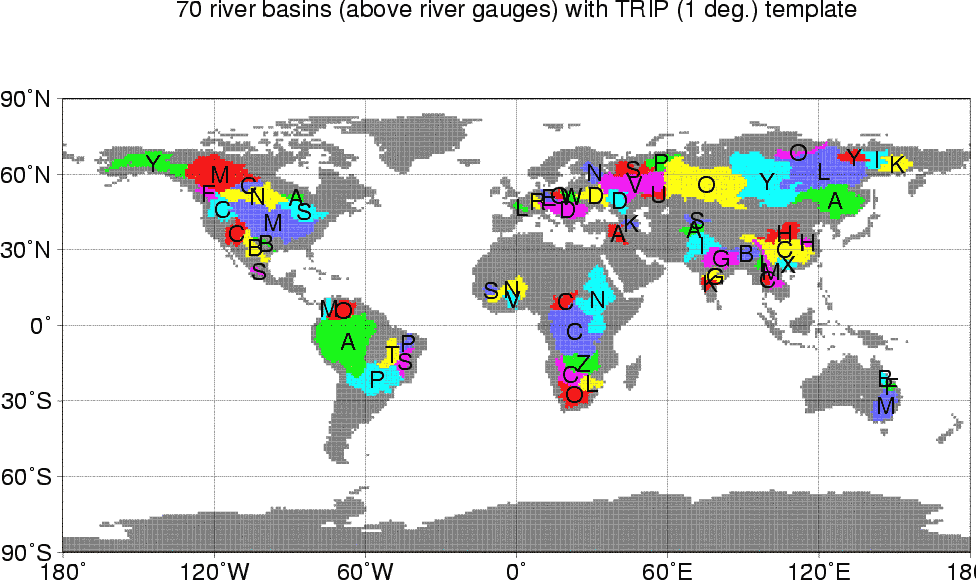 1 degree latitude/longitude grids, following
Total Runoff Integrated Pathways (Oki and Sud, 1998)
1 degree latitude/longitude grids, following
Total Runoff Integrated Pathways (Oki and Sud, 1998)
- x: Runoff (river discharge at station / drainage area of the station)
- y: moisture Convergence (European Centre for Medium-range Weather Forecasts Re-Analysis for 15-year period, processed by A. Yatagai [RIHN Kyoto])
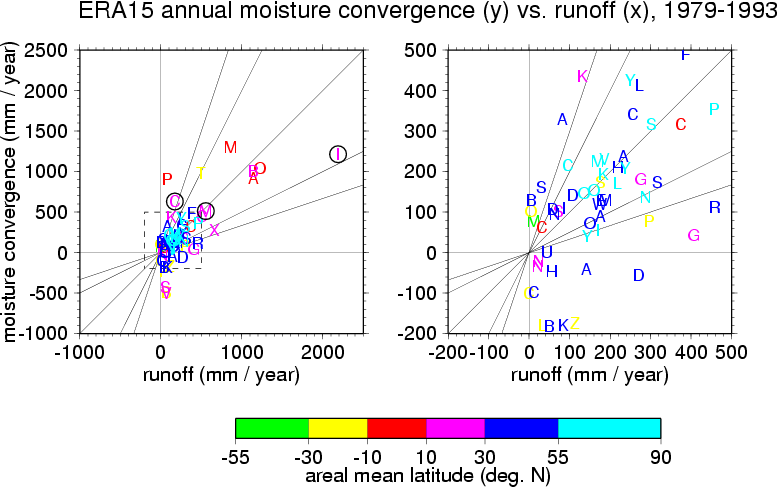 Chao Phraya, Mekong and Irrawaddy are circled.
In the following analysis, C is adjusted so that it matches R in long-term average.
Chao Phraya, Mekong and Irrawaddy are circled.
In the following analysis, C is adjusted so that it matches R in long-term average.
1979-1993, with ERA15
Mekong ---------- Chang Jiang (Yangtze) ---------- Huang He (Yellow)
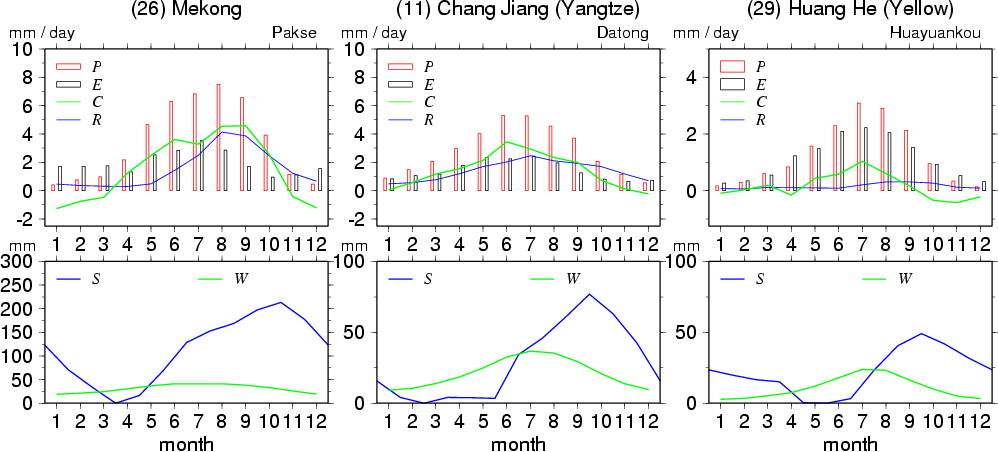
(S is shown as values relative to its minimum in the annual cycle.)
Tropics and temperate East Asia: S takes maximum at the end of rainy season.
1979-1993, with ERA15
Huang He (Yellow) ---------- Amur (Heilong Jiang) ---------- Lena
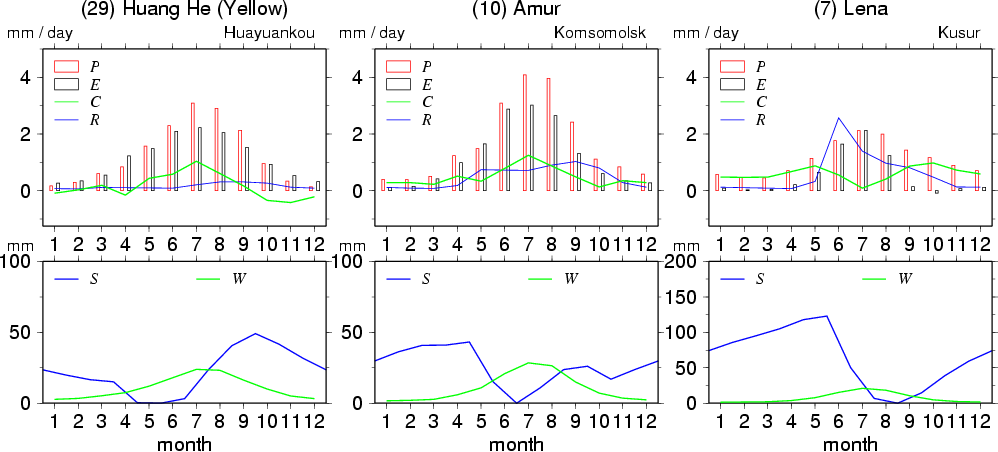
(S is shown as values relative to its minimum in the annual cycle.)
Temperate East Asia: S takes maximum at the end of rainy season.
Cold region: S takes maximum at the snowmelt season.
1979-1993, with ERA15
Chang Jiang (Yangtze) ---------- Mississippi ---------- Parana (La Plata)
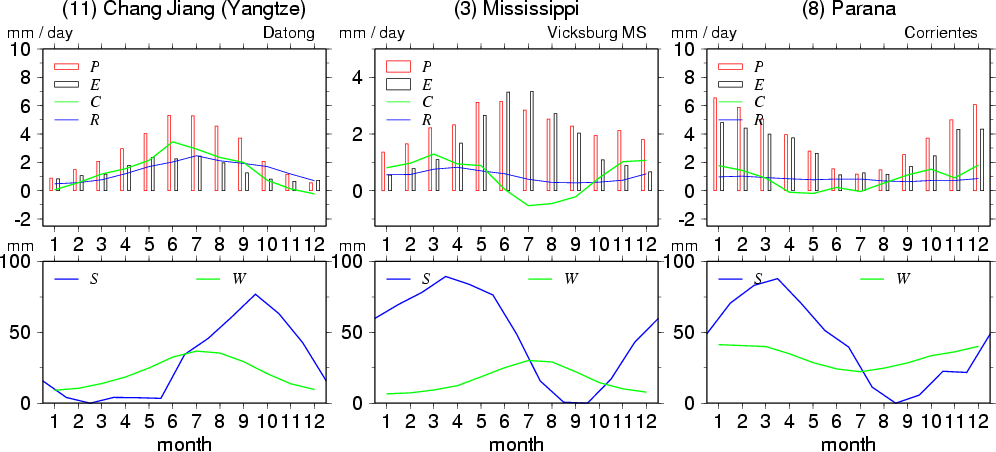
(S is shown as values relative to its minimum in the annual cycle.)
Temperate East Asia & South America: S takes maximum at the end of rainy season
Temperate North America: S takes maximum in spring.
1979-1993, with ERA15
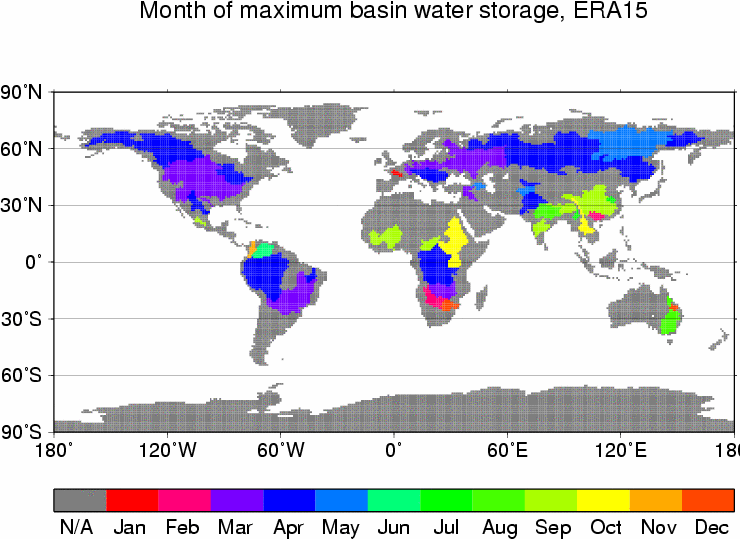
- Land: S for 1979-1993 with ERA15 and river runoff data
- Ocean: sea level from satellite altimeter, density from ship obs. temp. & salinity
- Vapor: NASA VAPor data set, combination of satellite and sonde obs.
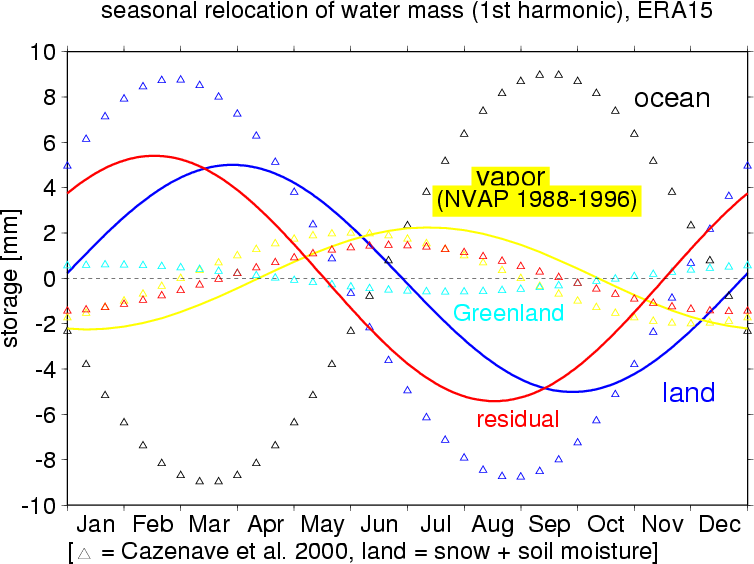
- Types of heat transfer
- Conduction: transfer of molecular energy without movement of mass
- Convection (broader sense): transfer of energy with movement of mass
- Radiation: transfer of mass by electromagnetic waves
- Energy contained by (unit mass of) air
- Potential energy ... g z [g: acceleration of gravity; z: height]
- Internal energy
- "Sensible" part ... Cv T [Cv: specific heat; T: absolute temperature]
- Latent part ... L q [L: latent heat per mass of water; q: specific humidity]
- Kinetic energy ... (1/2) v2 [v: wind speed] (relatively small)
- Exchange of energy at the top of the atmosphere ... radiation only
- Solar (shortwave) radiation ... visible and near-infra-red
- Terrestrial (longwave) radiation ... infra-red
- Exchange of energy at the (land/sea) surface ... Rnet = H + L E + G
- Rnet(d): Net Radiation (solar and terrestrial)
- H(u): Sensible Heat flux to atmosphere (conduction, small-scale convection)
- L E(u): Latent heat flux of evaporation (E: mass flux of evaporation)
- G(d): Net heat flux below surface (conduction, small-scale convection)
- (u) upward positive; (d) downward positive
Storage terms [J / m2]
- Ea: atmospheric energy storage; Eo: oceanic or terrestrial energy storage
Flux terms [J /(m2 s)] or [W / m2]
- Rnet,top: net radiation at the top; div Fa: div. of atmospheric energy transport;
- div Fo: div. of oceanic energy transport;
- G: net downward energy flux at the surface
For steady state (long-term mean), G = 0.
For global domain, div Fa = div Fo = 0.
Annual and zonal average
based on satellite observations (ERBE S4 NFOV) Feb. 1985 - Apr. 1989

Feb. 1985 - Apr. 1989 (period of ERBE S4 NFOV data)
- Radiation at the top of atmosphere: satellite observation (ERBE S4 NFOV)
- Atmosphere: "Reanalysis" products (two versions of U.S. NCEP)
- Ocean: residual
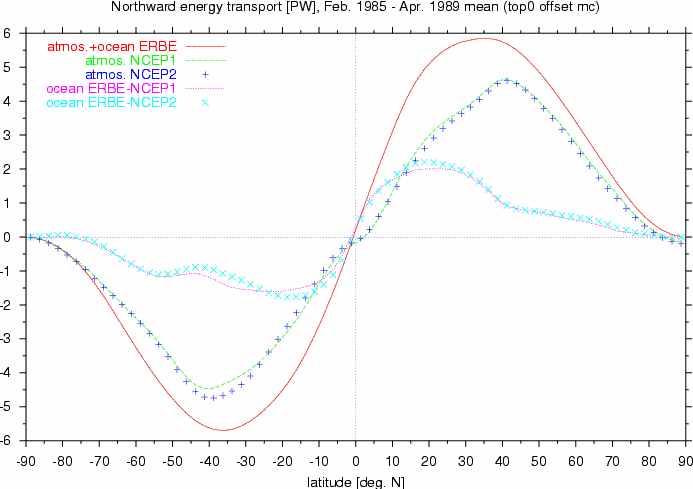 cf. Trenberth & Caron 2001, J. Climate; Masuda 1988 Tellus
cf. Trenberth & Caron 2001, J. Climate; Masuda 1988 Tellus
Feb. 1985 - Apr. 1989, "Reanalysis" products (two versions of NCEP)
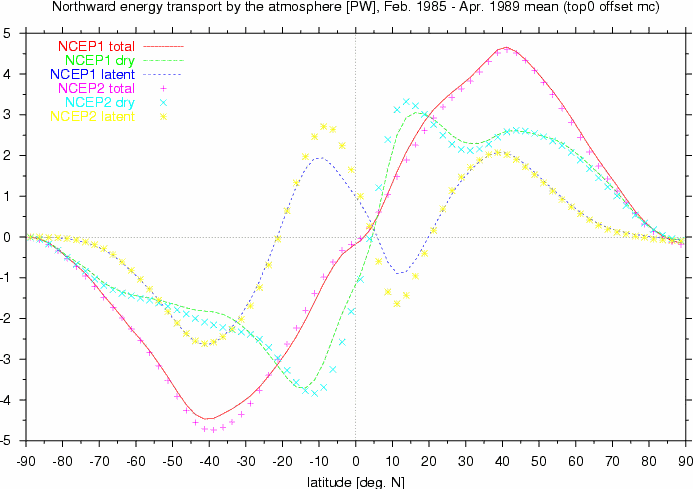
- Tropics: meridional-vertical overturning (quantitatively still large uncertainty)
- Water vapor (mainly near the surface) toward equator
- "Dry energy" (mainly about 15 km height) away from equator
- Middle latitudes: both water vapor and "dry energy" toward poles


